 If there’s one thing you need to know about the design team at Prospero Hall, it’s that they won’t rest until they’ve made a family-weight game based on every movie in the history of cinema. It’s their confirmed mission statement. It’s slapped above their office door like Ted Lasso’s “Believe” banner. It’s on their business cards. It’s their thing.
If there’s one thing you need to know about the design team at Prospero Hall, it’s that they won’t rest until they’ve made a family-weight game based on every movie in the history of cinema. It’s their confirmed mission statement. It’s slapped above their office door like Ted Lasso’s “Believe” banner. It’s on their business cards. It’s their thing.
So, since I’m Board Game Quest’s unofficial official movie person, I have a long-standing relationship with Prospero Hall and their movie-related designs (which, again, means essentially all their designs). Today I’m looking at one of their recent releases, so that means it’s based on a movie from 40 years ago.
E.T. The Extra-Terrestrial: Light Years from Home Game (yes, that’s the actual title) is an adventure game for 2-4 players that takes about a half-hour to play.
Gameplay Overview:
E.T. The Longest Title Ever Adventure Coop Game is a cooperative set collection and pickup-and-deliver game in which players are trying to grab items and place them onto like-colored spots on the board. To do this, every player (who controls one of the kid characters from the movie) will have the option of taking a bunch of actions on their turns. Each Kid technically only gets three actions, but there are also a half-dozen or so “free” actions that are always available. I could explain each one, but Board Game Quest is currently suffering from a severe ink shortage, so I won’t go through them all.
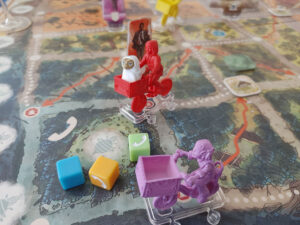
In effect, all the actions are variations on the game’s primary mechanism, which is running around (movement), grabbing stuff (pick up an item), and dropping said stuff off at the correct location on the board. (That last thing is one of the free actions… for some reason. The reasons why some actions are free and others aren’t, is a bit hard to explain, which is something I’ll be speaking about in my TED Talk on the Game’s Experience, the transcript of which is posted below under “Game Experience.”)
After each player has taken all their actions, they will be able to try to “Phone Home” to E.T.’s mothership (more on that later) and then they’ll have to move all the bad guys on the board by rolling some dice (at least two, but sometimes three if the Kids end their turn on the same spot or with E.T.). The villain movement phase can be swingy, but it is pretty neat to see how they all move in various ways around the board to chase down the Kids. There are even police cars that move on predetermined routes and can trigger the end game if they surround the game’s exit space. I don’t know how ultimately “fair” the random movement is, but it’s one of the things in the game that felt the most like the movie.
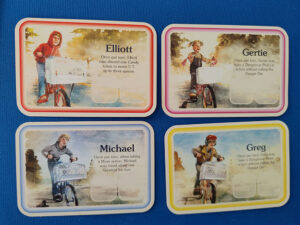
I mentioned earlier that players get to try to summon E.T.’s mothership every turn and this is done by rolling “device” dice that the team has been able to build to that point. To build the devices, players must drop items onto the matching-colored spaces on the board (there are three of them) and then have E.T. waddle over near the space to “build” the device. (I say “waddle” because the E.T. mini is swaddled like a baby, so he isn’t exactly built for speed.) Players will then have to transport this newly built device dice in their neat bicycle basket to the mothership takeoff space where it can be rolled later.
While the game isn’t difficult to play, there are a lot of minor rules to watch out for. Moving through enemy spaces is fine, but you must immediately roll a bad guy die and move some of them. There are also certain items that give you ramps so you can skip over spots and then there are the for-sure-not-Reese’s-because-that-would-cost-money-to-put-into-the-game candy tokens, which will cost you a non-free action to collect on your turn, but then can be used as a free action to move E.T. away from danger. (That doesn’t seem to make sense, right?)
Everybody wins if E.T.’s mothership gets to the exit space, and everybody loses if the exit space is completely surrounded or if E.T.’s health is at 0 (he loses health whenever he or any player ends their turn on a bad guy’s space).
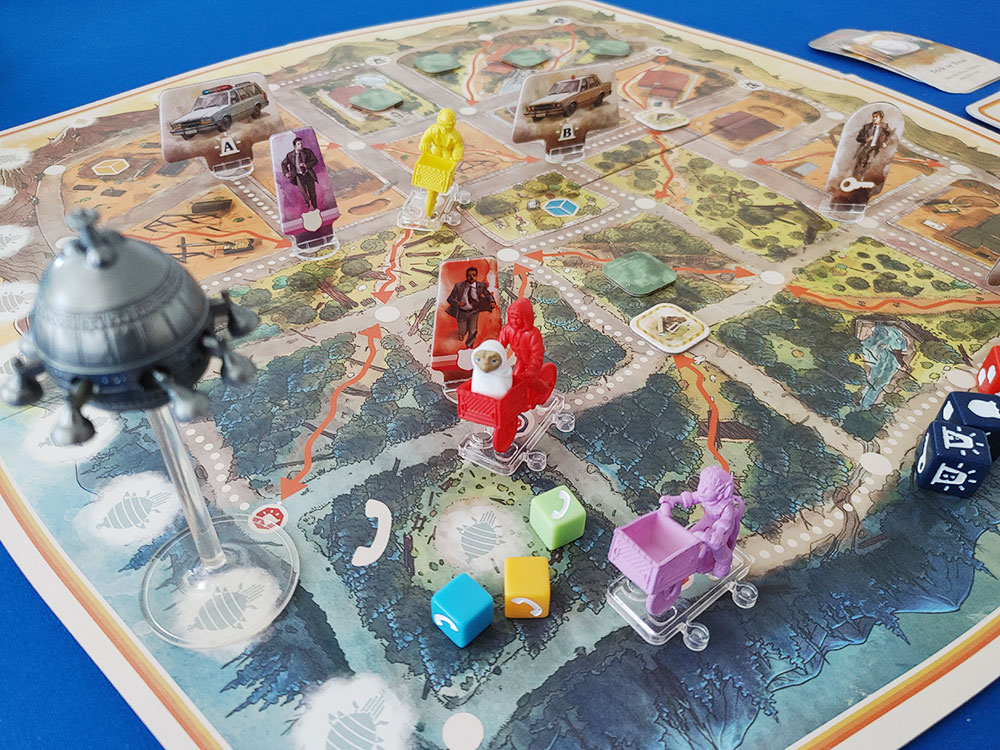
Game Experience:
Like seemingly all of Prospero Hall’s games, the best part of E.T. is the way its theme is integrated into the gameplay. The game feels like the final scene of the movie as you (and up to three of your friends!) are racing through town while trying to avoid government goons who want to do experiments on your alien pal. This is the charm of these IP games Prospero Hall offers and, often, their curse. In keeping the game thematically strong, any real attempt at gameplay depth is completely forfeited. Sure, the target audience is, well, a Target audience, but the game is so straightforward that it’s almost pointless to bother explaining any of the nuances of the rules.
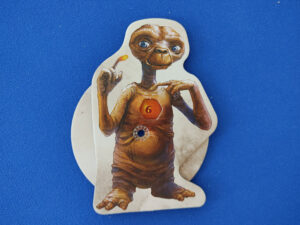
At the same time, however, there are an odd number of odd rules. Some actions are actions while others are actions, but don’t count as an action during your turn. There are other, kinda free actions players can take in the form of the E.T. deck of cards so long as E.T. is in your basket. Thematically, these actually never make sense, but are usually powerful. Similarly, E.T. can move by spending candy (which isn’t an action), but the Kids move without spending candy (but it is an action). These distinctions without much difference are all over this game and it’s both difficult to internalize and, frankly, pointless to try. In our plays, we all just did a bunch of stuff on every turn and did our best to properly quantify what was being done. (Every Kid also has a special power. This is not only kinda goofy thematically but adds another free action at each player’s disposal every turn.)
Coupled with this incongruous “easy to play despite the difficult ruleset” dichotomy is the game’s baffling terminology when it comes to spaces on the board. Spaces are different than zones are different than roads are different than shortcuts and each of these things can be nearby one another, which might make interacting with certain spaces/zones/regions more and/or less dangerous. There’s a whole page with diagrams and charts in the rulebook to help everyone make sense of this. (It’s actually the very first page of the book. It’s like the designers knew it was confounding.) Again, in practice, none of this is difficult to understand, but I spent so much time second-guessing whether I actually did understand it that I could have probably snuck in an additional play of the game during each sitting.
Final Thoughts:
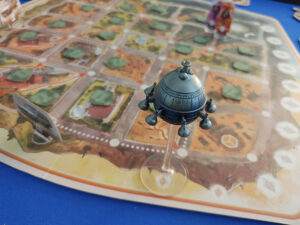
I’m not trying to be overly negative, and I do think there are a few bright spots in E.T. The Extra-Terrestrial: Light Years from Home Game. The way the villains move is pretty inspired (even though it’s all dependent on dice rolling) and the theme really shines as you play through the game. (Go ahead and try not to hum the movie’s musical score as you hit one of the ramps strewn around the map in the later stages of the game.) The problem is that the theme, while strong, might not resonate a whole lot for the game’s target age range (given its difficulty, that is).
My final criticism in this almost fun, almost a game, game is that at some point, all anyone is doing is rolling dice and stalling the inevitable ending one way or the other. The game isn’t particularly difficult nor is it incredibly easy, but once players have done enough work to build the devices, all they’ll be doing is rolling those device dice every turn and playing keep away with the titular alien in the hopes, they’ll hit enough phone icons to get the mothership to the exit space. Sure, there are ways to move the mothership without rolling, but basically, every game will come down to a roll off between the players’ device dice and the automated baddies’ movement dice. It’s kinda like playing Yahtzee against oneself: someone will win, but really, everybody loses.
Final score: 2.5 Stars – E.T. is occasionally fun—especially in the moments when it successfully calls to mind the climax of the movie it’s based on—but quirky rules, swingy gameplay, and a strange game arc make this one an unsatisfying experience.
 Hits:
Hits:
• Some components are really neat
• Easy to play
• Great theme integration
• It really evokes the feeling of being chased from the movie
Misses:
• Some components really aren’t neat
• There’s an awful lot of dice rolling
• Turns tend to feel samey after a few rounds
• Some terminology is unnecessarily confusing





















